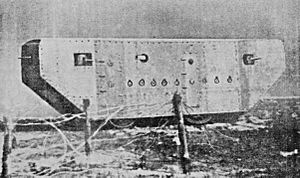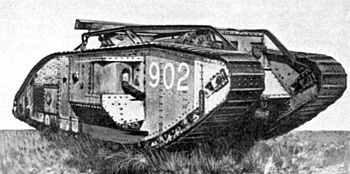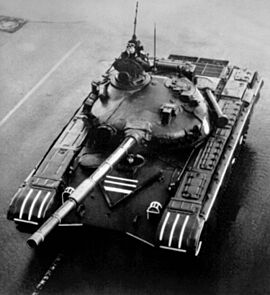Tank facts for kids
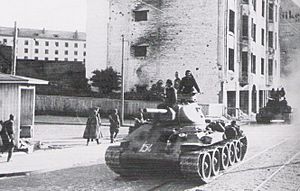
A tank is an armoured combat vehicle, typically armed with a large cannon mounted on a turret and a few machine guns.
A tank is covered in thick armour to protect it from enemy weapons. Tanks have tracks that wrap around its wheels to spread out its weight and let it cross rough ground. Most tanks have a powerful gun and one or more machine guns.
A tank's crew is normally 3-5. A driver, commander and gunner are always present. There may also be a loader, who handles the ammunition for the main gun (so the gunner doesn't have to take eyes off the target). Some WWII tanks also had a separate soldier responsible for the radio.
Contents
History
Conceptions
The tank is the 20th-century realization of an ancient concept: that of providing troops with mobile protection and firepower. The internal combustion engine, armour plate, and continuous track were key innovations leading to the invention of the modern tank.
During the 119 BC Battle of Mobei of the Han–Xiongnu War, the Han general Wei Qing led his army through a fatiguing expeditionary march across the Gobi desert only to find Yizhixie chanyu's main force waiting to encircle them on the other side. Using armored heavy wagons known as "Wu Gang Wagon" (Chinese: 武剛車) in ring formations that provided Chinese archers, crossbowmen and infantry protection from the Xiongnu's powerful cavalry charges, and allowed Han troops to utilize their ranged weapons' advantages of precision. This forced a stalemate and allowed time for his troops to recover strength, before using the cover of a sandstorm to launch a counteroffensive which overran the nomads.
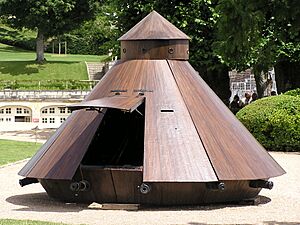
Many sources imply that Leonardo da Vinci and H. G. Wells in some way foresaw or "invented" the tank. Leonardo's late-15th-century drawings of what some describe as a "tank" show a man-powered, wheeled vehicle surrounded by cannons. However, the human crew would have difficulty moving the heavy vehicle over long distances, while usage of animals was problematic in a space so confined. In the 15th century, Jan Žižka built armoured wagons known as ‘Wagenburg’ containing cannons and used them effectively in several battles during the Hussite-wars. The continuous "caterpillar track" arose from attempts to improve the mobility of wheeled vehicles by spreading their weight, reducing ground pressure, and increasing their traction. Experiments can be traced back as far as the 17th century, and by the late nineteenth they existed in various recognizable and practical forms in several countries.
It is frequently claimed that Richard Lovell Edgeworth created a caterpillar track. It is true that in 1770 he patented a "machine, that should carry and lay down its own road", but this was Edgeworth's choice of words. His own account in his autobiography is of a horse-drawn wooden carriage on eight retractable legs, capable of lifting itself over high walls. The description bears no similarity to a caterpillar track. Armoured trains appeared in the mid-19th century, and various armoured steam and petrol-engined vehicles were also proposed.
The machines described in Wells's 1903 short story The Land Ironclads are a step closer, insofar as they are armour-plated, have an internal power plant, and are able to cross trenches. Some aspects of the story foresee the tactical use and impact of the tanks that later came into being. However, Wells's vehicles were driven by steam and moved on pedrail wheels, technologies that were already outdated at the time of writing. After seeing British tanks in 1916, Wells denied having "invented" them, writing, "Yet let me state at once that I was not their prime originator. I took up an idea, manipulated it slightly, and handed it on." It is, though, possible that one of the British tank pioneers, Ernest Swinton, was subconsciously or otherwise influenced by Wells's tale.
The first combinations of the three principal components of the tank appeared in the decade before World War One. In 1903, Captain Léon René Levavasseur of the French artillery proposed mounting a field gun in an armoured box on tracks. Major William E. Donohue, of the British Army's Mechanical Transport Committee, suggested fixing a gun and armoured shield on a British type of track-driven vehicle. The first armoured car was produced in Austria in 1904. However, all were restricted to rails or reasonably passable terrain. It was the development of a practical caterpillar track that provided the necessary independent, all-terrain mobility.
In a memorandum of 1908, Antarctic explorer Robert Falcon Scott presented his view that man-hauling to the South Pole was impossible and that motor traction was needed. Snow vehicles did not yet exist, however, and so his engineer Reginald Skelton developed the idea of a caterpillar track for snow surfaces. These tracked motors were built by the Wolseley Tool and Motor Car Company in Birmingham and tested in Switzerland and Norway, and can be seen in action in Herbert Ponting's 1911 documentary film of Scott's Antarctic Terra Nova Expedition. Scott died during the expedition in 1912, but expedition member and biographer Apsley Cherry-Garrard credited Scott's "motors" with the inspiration for the British World War I tanks, writing: "Scott never knew their true possibilities; for they were the direct ancestors of the 'tanks' in France".
In 1911, a Lieutenant Engineer in the Austrian Army, Günther Burstyn, presented to the Austrian and Prussian War Ministries plans for a light, three-man tank with a gun in a revolving turret, the so-called Burstyn-Motorgeschütz. In the same year an Australian civil engineer named Lancelot de Mole submitted a basic design for a tracked, armoured vehicle to the British War Office. In Russia, Vasiliy Mendeleev designed a tracked vehicle containing a large naval gun. All of these ideas were rejected and, by 1914, forgotten (although it was officially acknowledged after the war that de Mole's design was at least the equal to the initial British tanks). Various individuals continued to contemplate the use of tracked vehicles for military applications, but by the outbreak of the War no one in a position of responsibility in any army seems to have given much thought to tanks.
World War I
United Kingdom
The direct military impact of the tank can be debated but its effect on the Germans was immense, it caused bewilderment, terror and concern in equal measure. It was also a huge boost to the civilians at home. After facing the Zeppelins, at last Britain had a wonder weapon. Tanks were taken on tours and treated almost like film stars.
From late 1914 a small number of middle-ranking British Army officers tried to persuade the War Office and the Government to consider the creation of armoured vehicles. Amongst their suggestions was the use of caterpillar tractors, but although the Army used many such vehicles for towing heavy guns, it could not be persuaded that they could be adapted as armoured vehicles. The consequence was that early tank development in the United Kingdom was carried out by the Royal Navy.
As the result of an approach by Royal Naval Air Service officers who had been operating armoured cars on the Western Front, the First Lord of the Admiralty, Winston Churchill, formed the Landship Committee, on 20 February 1915. The Director of Naval Construction for the Royal Navy, Eustace Tennyson d'Eyncourt, was appointed to head the Committee in view of his experience with the engineering methods it was felt might be required; the two other members were naval officers, and a number of industrialists were engaged as consultants. So many played a part in its long and complicated development that it is not possible to name any individual as the sole inventor of the tank.
However leading roles were played by Lt Walter Gordon Wilson R.N. who designed the gearbox and developed practical tracks and by William Tritton whose agricultural machinery company, William Foster & Co. in Lincoln, Lincolnshire, England built the prototypes. On 22 July 1915, a commission was placed to design a machine that could cross a trench 4 ft wide. Secrecy surrounded the project with the designers locking themselves in a room at the White Hart Hotel in Lincoln. The committee's first design, Little Willie, ran for the first time in September 1915 and served to develop the form of the track but an improved design, better able to cross trenches, swiftly followed and in January 1916 the prototype, nicknamed "Mother", was adopted as the design for future tanks. The first order for tanks was placed on 12 February 1916, and a second on 21 April. Fosters built 37 (all "male"), and Metropolitan Railway Carriage and Wagon Company, of Birmingham, 113 (38 "male" and 75 "female"), a total of 150. Production models of "Male" tanks (armed with naval cannon and machine guns) and "Females" (carrying only machine-guns) would go on to fight in history's first tank action at the Somme in September 1916. Great Britain produced about 2,600 tanks of various types during the war. The first tank to engage in battle was designated D1, a British Mark I Male, during the Battle of Flers-Courcelette (part of the wider Somme offensive) on 15 September 1916. Bert Chaney, a nineteen-year-old signaller with the 7th London Territorial Battalion, reported that "three huge mechanical monsters such as [he] had never seen before" rumbled their way onto the battlefield, "frightening the Jerries out of their wits and making them scuttle like frightened rabbits." When the news of the first use of the tanks emerged, Prime Minister David Lloyd George commented,
It is really to Mr Winston Churchill that the credit is due more than to anyone else. He took up with enthusiasm the idea of making them a long time ago, and he met with many difficulties. He converted me, and at the Ministry of Munitions he went ahead and made them. The admiralty experts were invaluable, and gave the greatest possible assistance. They are, of course, experts in the matter of armour plating. Major Stern, (formerly an officer in the Royal Naval Air Service) a business man at the Ministry of Munitions had charge of the work of getting them built, and he did the task very well. Col Swinton and others also did valuable work.
France
Whilst several experimental machines were investigated in France, it was a colonel of artillery, J.B.E. Estienne, who directly approached the Commander-in-Chief with detailed plans for a tank on caterpillar tracks, in late 1915. The result was two largely unsatisfactory types of tank, 400 each of the Schneider and Saint-Chamond, both based on the Holt tractor.
The following year, the French pioneered the use of a full 360° rotation turret in a tank for the first time, with the creation of the Renault FT light tank, with the turret containing the tank's main armament. In addition to the traversable turret, another innovative feature of the FT was its engine located at the rear. This pattern, with the gun located in a mounted turret and the engine at the back, has become the standard for most succeeding tanks across the world even to this day. The FT was the most numerous tank of the war; over 3,000 were made by late 1918.
Germany
Germany fielded very few tanks during World War I, and started development only after encountering British tanks on the Somme. The A7V, the only type made, was introduced in March 1918 with just 20 being produced during the war. The first tank versus tank action took place on 24 April 1918 at the Second Battle of Villers-Bretonneux, France, when three British Mark IVs met three German A7Vs. Captured British Mk IVs formed the bulk of Germany's tank forces during World War I; about 35 were in service at any one time. Plans to expand the tank programme were under way when the War ended.
Other nations
The United States Tank Corps used tanks supplied by France and Great Britain during World War I. Production of American-built tanks had just begun when the War came to an end. Italy also manufactured two Fiat 2000s towards the end of the war, too late to see service. Russia independently built and trialed two prototypes early in the War; the tracked, two-man Vezdekhod and the huge Lebedenko, but neither went into production. A tracked self-propelled gun was also designed but not produced.
Although tank tactics developed rapidly during the war, piecemeal deployments, mechanical problems, and poor mobility limited the military significance of the tank in World War I, and the tank did not fulfil its promise of rendering trench warfare obsolete. Nonetheless, it was clear to military thinkers on both sides that tanks in some way could have a significant role in future conflicts.
Interwar period
In the interwar period tanks underwent further mechanical development. In terms of tactics, J.F.C. Fuller's doctrine of spearhead attacks with massed tank formations was the basis for work by Heinz Guderian in Germany, Percy Hobart in Britain, Adna R. Chaffee, Jr., in the US, Charles de Gaulle in France, and Mikhail Tukhachevsky in the USSR. Liddell Hart held a more moderate view that all arms – cavalry, infantry and artillery – should be mechanized and work together. The British formed the all-arms Experimental Mechanized Force to test the use of tanks with supporting forces.
In the Second World War only Germany would initially put the theory into practice on a large scale, and it was their superior tactics and French blunders, not superior weapons, that made the "blitzkrieg" so successful in May 1940. For information regarding tank development in this period, see tank development between the wars.
Germany, Italy and the Soviet Union all experimented heavily with tank warfare during their clandestine and "volunteer" involvement in the Spanish Civil War, which saw some of the earliest examples of successful mechanized combined arms —such as when Republican troops, equipped with Soviet-supplied tanks and supported by aircraft, eventually routed Italian troops fighting for the Nationalists in the seven-day Battle of Guadalajara in 1937. However, of the nearly 700 tanks deployed during this conflict, only about 64 tanks representing the Franco faction and 331 from the Republican side were equipped with cannon, and of those 64 nearly all were World War I vintage Renault FT tanks, while the 331 Soviet supplied machines had 45mm main guns and were of 1930s manufacture. The balance of Nationalist tanks were machine gun armed. The primary lesson learned from this war was that machine gun armed tanks had to be equipped with cannon, with the associated armour inherent to modern tanks.
The five-month-long war between the Soviet Union and the Japanese 6th Army at Khalkhin Gol (Nomonhan) in 1939 brought home some lessons. In this conflict, the Soviets fielded over two thousand tanks, to the around 73 cannon armed tanks deployed by the Japanese, the major difference being that Japanese armour were equipped with diesel engines as opposed to the Russian tanks equipped with petrol engines. After General Georgy Zhukov inflicted a defeat on the Japanese 6th Army with his massed combined tank and air attack, the Soviets learned a lesson on the use of gasoline engines, and quickly incorporated those newly found experiences into their new T-34 medium tank during World War II.
Prior to World War II, the tactics and strategy of deploying tank forces underwent a revolution. In August 1939, Soviet General Georgy Zhukov used the combined force of tanks and airpower at Nomonhan against the Japanese 6th Army; Heinz Guderian, a tactical theoretician who was heavily involved in the formation of the first independent German tank force, said "Where tanks are, the front is", and this concept became a reality in World War II. Guderian's armoured warfare ideas, combined with Germany's existing doctrines of Bewegungskrieg ("maneuver warfare") and infiltration tactics from World War I, became the basis of blitzkrieg in the opening stages of World War II.
World War II
During World War II, the first conflict in which armoured vehicles were critical to battlefield success, the tank and related tactics developed rapidly. Armoured forces proved capable of tactical victory in an unprecedentedly short amount of time, yet new anti-tank weaponry showed that the tank was not invulnerable. During the Invasion of Poland, tanks performed in a more traditional role in close cooperation with infantry units, but in the Battle of France deep independent armoured penetrations were executed by the Germans, a technique later called blitzkrieg. Blitzkrieg used innovative combined arms tactics and radios in all of the tanks to provide a level of tactical flexibility and power that surpassed that of the Allied armour. The French Army, with tanks equal or superior to the German tanks in both quality and quantity, employed a linear defensive strategy in which the armoured cavalry units were made subservient to the needs of the infantry armies to cover their entrenchment in Belgium. In addition, they lacked radios in many of their tanks and headquarters, which limited their ability to respond to German attacks.
In accordance with blitzkrieg methods, German tanks bypassed enemy strongpoints and could radio for close air support to destroy them, or leave them to the infantry. A related development, motorized infantry, allowed some of the troops to keep up with the tanks and create highly mobile combined arms forces. The defeat of a major military power within weeks shocked the rest of the world, spurring tank and anti-tank weapon development.
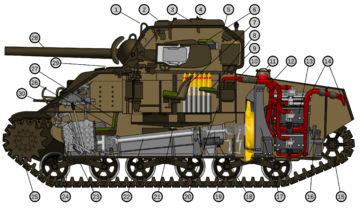
The North African Campaign also provided an important battleground for tanks, as the flat, desolate terrain with relatively few obstacles or urban environments was ideal for conducting mobile armoured warfare. However, this battlefield also showed the importance of logistics, especially in an armoured force, as the principal warring armies, the German Afrika Korps and the British Eighth Army, often outpaced their supply trains in repeated attacks and counter-attacks on each other, resulting in complete stalemate. This situation would not be resolved until 1942, when during the Second Battle of El Alamein, the Afrika Korps, crippled by disruptions in their supply lines, had 95% of its tanks destroyed and was forced to retreat by a massively reinforced Eighth Army, the first in a series of defeats that would eventually lead to the surrender of the remaining Axis forces in Tunisia.

When Germany launched its invasion of the Soviet Union, Operation Barbarossa, the Soviets had a superior tank design, the T-34. A lack of preparations for the Axis surprise attack, mechanical problems, poor training of the crews and incompetent leadership caused the Soviet machines to be surrounded and destroyed in large numbers. However, interference from Adolf Hitler, the geographic scale of the conflict, the dogged resistance of the Soviet combat troops, and the Soviets' massive advantages in manpower and production capability prevented a repeat of the German successes of 1940. Despite early successes against the Soviets, the Germans were forced to up-gun their Panzer IVs, and to design and build both the larger and more expensive Tiger heavy tank in 1942, and the Panther medium tank the following year. In doing so, the Wehrmacht denied the infantry and other support arms the production priorities that they needed to remain equal partners with the increasingly sophisticated tanks, in turn violating the principle of combined arms they had pioneered. Soviet developments following the invasion included upgunning the T-34, development of self-propelled anti-tank guns such as the SU-152, and deployment of the IS-2 in the closing stages of the war, with the T-34 being the most produced tank of World War II, totalling up to some 65,000 examples by May 1945.
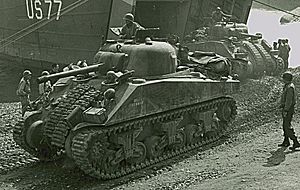
Much like the Soviets, when entering World War II six months later (December 1941), the United States' mass production capacity enabled it to rapidly construct thousands of relatively cheap M4 Sherman medium tanks. A compromise all round, the Sherman was reliable and formed a large part of the Anglo-American ground forces, but in a tank-versus-tank battle was no match for the Panther or Tiger. Numerical and logistical superiority and the successful use of combined arms allowed the Allies to overrun the German forces during the Battle of Normandy. Upgunned versions with the 76 mm gun M1 and the 17-pounder were introduced to improve the M4's firepower, but concerns about protection remained—despite the apparent armour deficiencies, a total of some 42,000 Shermans were built and delivered to the Allied nations using it during the war years, a total second only to the T-34.
Tank hulls were modified to produce flame tanks, mobile rocket artillery, and combat engineering vehicles for tasks including mine-clearing and bridging. Specialized self-propelled guns, most of which could double as tank destroyers, were also both developed by the Germans—with their Sturmgeschütz, Panzerjäger and Jagdpanzer vehicles—and the Samokhodnaya ustanovka families of AFV's for the Soviets: such turretless, casemate-style tank destroyers and assault guns were less complex, stripped down tanks carrying heavy guns, solely firing forward. The firepower and low cost of these vehicles made them attractive but as manufacturing techniques improved and larger turret rings made larger tank guns feasible, the gun turret was recognized as the most effective mounting for the main gun to allow movement in a different direction from firing, enhancing tactical flexibility.
Cold War
During the Cold War, tension between the Warsaw Pact countries and North Atlantic Treaty Organization (NATO) countries created an arms race that ensured that tank development proceeded largely as it had during World War II. The essence of tank designs during the Cold War had been hammered out in the closing stages of World War II. Large turrets, capable suspension systems, greatly improved engines, sloped armour and large-caliber (90 mm and larger) guns were standard. Tank design during the Cold War built on this foundation and included improvements to fire control, gyroscopic gun stabilization, communications (primarily radio) and crew comfort and saw the introduction of laser rangefinders and infrared night vision equipment. Armour technology progressed in an ongoing race against improvements in anti-tank weapons, especially antitank guided missiles like the TOW.
Medium tanks of World War II evolved into the main battle tank (MBT) of the Cold War and took over the majority of tank roles on the battlefield. This gradual transition occurred in the 1950s and 1960s due to anti-tank guided missiles, sabot ammunition and high-explosive anti-tank warheads. World War II had shown that the speed of a light tank was no substitute for armour & firepower and medium tanks were vulnerable to newer weapon technology, rendering them obsolete.
In a trend started in World War II, economies of scale led to serial production of progressively upgraded models of all major tanks during the Cold War. For the same reason many upgraded post-World War II tanks and their derivatives (for example, the T-55 and T-72) remain in active service around the world, and even an obsolete tank may be the most formidable weapon on battlefields in many parts of the world. Among the tanks of the 1950s were the British Centurion and Soviet T-54/55 in service from 1946, and the US M48 from 1951. These three vehicles formed the bulk of the armoured forces of NATO and the Warsaw Pact throughout much of the Cold War. Lessons learned from tanks such as the Leopard 1, M48 Patton series, Chieftain, and T-72 led to the contemporary Leopard 2, M1 Abrams, Challenger 2, C1 Ariete, T-90 and Merkava IV.
Tanks and anti-tank weapons of the Cold War era saw action in a number of proxy wars like the Korean War, Vietnam War, Indo-Pakistani War of 1971, Soviet–Afghan War and Arab-Israeli conflicts, culminating with the Yom Kippur War. The T-55, for example, has seen action in no fewer than 32 conflicts. In these wars the U.S. or NATO countries and the Soviet Union or China consistently backed opposing forces. Proxy wars were studied by Western and Soviet military analysts and provided a contribution to the Cold War tank development process.
21st century
The role of tank vs. tank combat is becoming diminished. Tanks work in concert with infantry in urban warfare by deploying them ahead of the platoon. When engaging enemy infantry, tanks can provide covering fire on the battlefield. Conversely, tanks can spearhead attacks when infantry are deployed in personnel carriers.
Tanks were used to spearhead the initial US invasion of Iraq in 2003. As of 2005, there were 1,100 M1 Abrams used by the United States Army in the course of the Iraq War, and they have proven to have an unexpectedly high level of vulnerability to roadside bombs. A relatively new type of remotely detonated mine, the explosively formed penetrator has been used with some success against American armoured vehicles (particularly the Bradley fighting vehicle). However, with upgrades to their armour in the rear, M1s have proven invaluable in fighting insurgents in urban combat, particularly at the Battle of Fallujah, where the US Marines brought in two extra brigades. Israeli Merkava tanks contain features that enable them to support infantry in low intensity conflicts (LIC) and counter-terrorism operations. Such features are the rear door and rear corridor, enabling the tank to carry infantry and embark safely; the IMI APAM-MP-T multi-purpose ammunition round, advanced C4IS systems and recently: TROPHY active protection system which protects the tank from shoulder-launched anti-tank weapons. During the Second Intifada further modifications were made, designated as "Merkava Mk. 3d Baz LIC".
Related pages
Images for kids
-
The first tank to engage in battle, the British Mark I tank (pictured in 1916) with the Solomon camouflage scheme
-
ectioned 105mm rifled Royal Ordnance L7 tank gun
-
PLA's Type 99a tank with disruptive camouflage painting
-
Concealed force: members of 122nd Tank Brigade camouflage their T-34 tank with natural materials as they prepare for the Siege of Leningrad, 1941
-
M1 Abrams offloading from Landing Craft Air Cushioned vehicle.
-
German Army Leopard 2A6M incorporates networked battlefield technology
-
Merkava Mark 4 main battle tank is equipped with a digital C4IS battle-management system.
See also
 In Spanish: Carro de combate para niños
In Spanish: Carro de combate para niños


